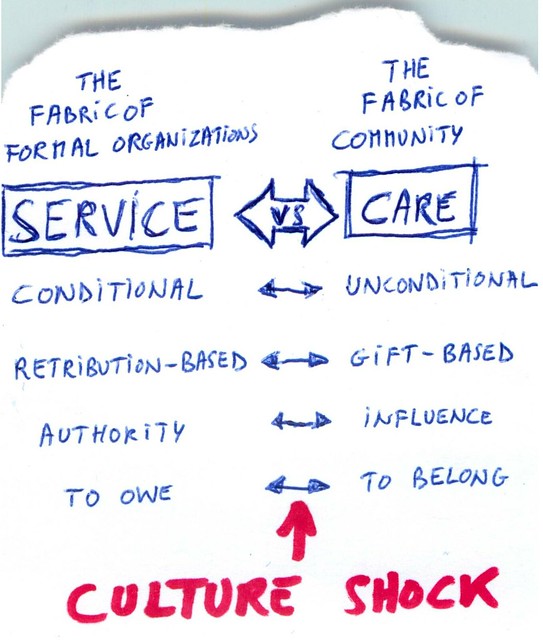Some musings on why it is so difficult for us to embrace the possibilities that are given to us by social media. My conclusion? It’s a culture shock between service and care and that’s just too much for us to take. Don’t expect practical advice from this blogpost. We are heading into uncharted territory.
In the previous post of this series we zoomed in on the insights of John McKnight and the difference that he makes between service and care. His main argument is that over the past generations we have replaced care (which is an unconditional action from one person to another) with service (which is based on the retribution). In that sense we have un-learned the sense of community in everything that we do. It has been replaced with the belief that everything we need can be bought with a service.
More than a decade ago the internet came, and if that didn’t change our worldview, the rise of social media has certainly turned things upside down. We are in the middle of a transformation that contrasts our highly individualistic culture against a collaborative culture.
With the same pace as social media have become mainstream, we are heading for a culture shock, and that culture shock is defined by the difference between service and care. Until a few years ago our world revolved around the idea that everything we need can be bought as a service. Now – since the immense popularity of social media – a new pattern of interaction and relationship becomes possible; i.e.: unconditional care. People are sharing content and information online, newspapers are under threat of civil journalism, so-called ‘pay-walls’ are under pressure and we see people helping each other online all the time.

Organizations are having a hard time keeping up with that new pattern of interaction because ‘care’ is not a dynamic that can be captured in a reporting line or an agreement. The premise of the organizations we are working in is based on the consumption of services. The more we can measure that, the better we feel about it. Since the Industrial Revolution, this is the dynamic that has changed our society and our expectations.
Some non-profit organizations are an exception to that, because in some cases, the sense of community is alive through the caring relationships. That’s a very particular context and we see that these types of organizations have no trouble adopting social media into their day-to-day lives. They only need minor rules and policing. By the way: most of them don’t have an HR department… another sign that people take responsibility over their own well-being and relatedness?
Yet, intuitively we know that what makes our organizations tick is the care people have for one another: co-workers, clients, suppliers, interest groups,… To say it with the words of Charles Handy:
We were not destined to be empty raincoats, nameless numbers on a payroll, role occupants, the raw material of economics or sociology, statistics in some government report.
Somewhere inside ourselves we know that this sense of community is what our organizations need so hard. Deep down inside we know that social media can connect people at the caring level. But from the outside we feel helpless, illiterate and … afraid… because we know that in a retributive context anything that is done unconditionally is regarded as strange and suspicious.
The truth is: we have always been a caring species and social media is just scratching the surface of what it means to humanize our organizations. It’s a culture shock – and a big one. Let’s recognize it for what it is the first place, pushing ourselves though that denial phase, and then we can dive into it.



Pingback: Getting Serious about Community Development (Part 9) | Reply-MC()